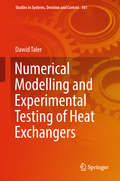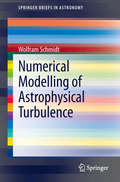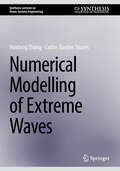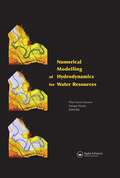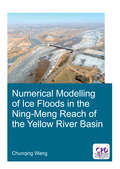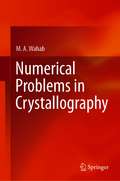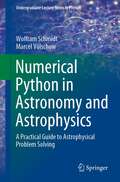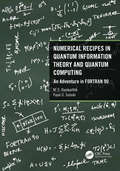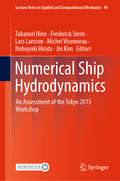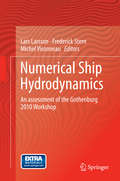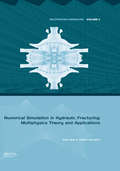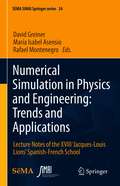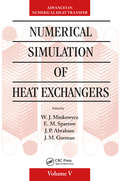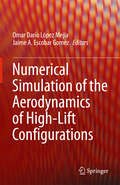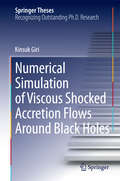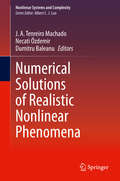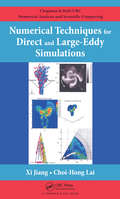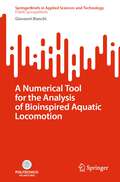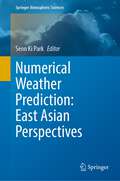- Table View
- List View
Numerical Modelling and Experimental Testing of Heat Exchangers (Studies in Systems, Decision and Control #161)
by Dawid TalerThis book presents new methods of numerical modelling of tube heat exchangers, which can be used to perform design and operation calculations of exchangers characterized by a complex flow system. It also proposes new heat transfer correlations for laminar, transition and turbulent flows. A large part of the book is devoted to experimental testing of heat exchangers, and methods for assessing the indirect measurement uncertainty are presented. Further, it describes a new method for parallel determination of the Nusselt number correlations on both sides of the tube walls based on the nonlinear least squares method and presents the application of computational fluid dynamic (CFD) modeling to determine the air-side Nusselt number correlations. Lastly, it develops a control system based on the mathematical model of the car radiator and compares this with the digital proportional-integral-derivative (PID) controller. The book is intended for students, academics and researchers, as well as for designers and manufacturers of heat exchangers.
Numerical Modelling and Optimization in Advanced Manufacturing Processes (Materials Forming, Machining and Tribology)
by Chander Prakash Sunpreet Singh Aminesh Basak J. Paulo DavimThis book presents different numerical modeling and nature-inspired optimization methods in advanced manufacturing processes for understanding the process characteristics. Particular emphasis is devoted to applications in non-conventional machining, nano-finishing, precision casting, porous biofabrication, three-dimensional printing, and micro-/nanoscale modeling. The book includes practical implications of empirical, analytical, and numerical models for predicting the vital output responses. Especial attention is given to finite element methods (FEMs) for understanding the design of novel highly complex engineering products, their performances, and behaviors under simulated processing conditions.
Numerical Modelling of Astrophysical Turbulence
by Wolfram SchmidtIn this "SpringerBrief" the author considers the underlying problems and questions that are common to numerical models of turbulence in different astrophysical systems. Turbulence has emerged as an important research topic in several areas of astrophysics. Understanding and modeling turbulence is particularly important for the dynamics of the interstellar medium, but also for the intergalactic medium, as well as in stars. The advancement of methods for numerical simulations of astrophysical turbulence, however, is still challenging because of gravity, strong compressibility, magnetic fields, and other effects. The book begins with a review of general aspects of numerical simulations of turbulence. In the main part the author presents findings from his numerical studies on astrophysical turbulence and discusses the astrophysical implications. He also explains in detail the numerical schemes utilized. Readers will find that this book offers a compact yet comprehensive introduction.
Numerical Modelling of Extreme Waves (Synthesis Lectures on Ocean Systems Engineering)
by Huidong Zhang Carlos Guedes SoaresThis book describes some approaches for developing the numerical models to efficiently predict the formation of extreme waves which can pose a threat to the safety of marine structures. The numerical algorithms for solving different governing equations and the theoretical probability models for extreme wave predictions are explained in detail. These models can help engineers in the design of marine structures that can withstand extreme waves. With more frequent extreme weather due to climate change, extreme waves have become more common. Extreme waves are an interesting phenomenon, but because of their enormous destructive power, understanding their formation mechanism, properties, and impact, is necessary for the design and safe operation of ships and offshore structures.
Numerical Modelling of Hydrodynamics for Water Resources: Proceedings of the Conference on Numerical Modelling of Hydrodynamic Systems (Zaragoza, Spain, 18-21 June 2007)
by Pilar García-Navarro Enrique PlayánThe presentations collected in this volume have a problem-oriented perspective, and focus on canal and river flow, riparian areas and aquifers. 'Numerical Modelling of Hydrodynamics for Water Resources' is highly relevant to those working in hydrology, civil engineering, and environmental and agricultural sectors.
Numerical Modelling of Ice Floods in the Ning-Meng Reach of the Yellow River Basin (IHE Delft PhD Thesis Series)
by Chunqing WangThe Ning-Meng reach of the Yellow River basin is located in the Inner Mongolia region at the Northern part of the Yellow River. Due to the special geographical conditions, the river flow direction is towards the North causing the Ning-Meng reach to freeze up every year in wintertime. Both during the freeze-up and break-up period, unfavourable conditions occur which may cause ice jamming and ice dam formation leading to dike breaching and overtopping of the embankment. Throughout history this has often led to considerable casualties and property loss. Enhanced economic development and human activities in the region have altered the characteristics of the ice regime in recent decades, leading to several ice disasters during freezing or breaking-up periods. The integrated water resources management plan developed by the Yellow River Conservancy Commission (YRCC) outlines the requirements for water regulation in the upper Yellow River during ice flood periods. YRCC is developing measures that not only safeguard against ice floods, but also assure the availability of adequate water resources. These provide the overall requirements for developing an ice regime forecasting system including lead-time prediction and required accuracy. In order to develop such a system, numerical modelling of ice floods is an essential component of current research at the YRCC, together with field observations and laboratory experiments. In order to properly model river ice processes it is necessary to adjust the hydrodynamic equations to account for thermodynamic effects. In this research, hydrological and meteorological data from 1950 to 2010 were used to analyse the characteristics of ice regimes in the past. Also, additional field observations were carried out for ice flood model calibration and validation. By combining meteorological forecasting models with statistical models, a medium to short range air temperature forecasting model for the Ning-Meng reach was established. These results were used to improve ice formation modelling and prolong lead-time prediction. The numerical ice flood model developed in this thesis for the Ning-Meng reach allows better forecasting of the ice regime and improved decision support for upstream reservoir regulation and taking appropriate measures for disaster risk reduction.
A Numerical Primer for the Chemical Engineer, Second Edition
by Edwin ZondervanDesigned as an introduction to numerical methods for students, this book combines mathematical correctness with numerical performance, and concentrates on numerical methods and problem solving. It applies actual numerical solution strategies to formulated process models to help identify and solve chemical engineering problems. Second edition comes with additional chapter on numerical integration and section on boundary value problems in the relevant chapter. Additional material on general modelling principles, mass/energy balances and separate section on DAE’s is also included. Case study section has been extended with additional examples.
Numerical Problems in Crystallography
by M. A. WahabThis book aims at enhancing the understanding of topics in crystallography through solving numerical problems. Designed into nine chapters on major topics in crystallography, the book deals with more than 600 carefully selected solved examples, problems, and multiple-choice questions. Unit cell composition, construction and calculations, Miller indices, structure factor calculations, and X-ray diffraction methods are some of the many useful topics discussed in this book. Each chapter begins with a brief theoretical explanation of the topic followed by solved numerical examples for further clarity on the subject. The topic “crystallography” is interdisciplinary in nature. Its rudimentary knowledge, therefore, is essential to the beginners in physics, chemistry, mathematics, molecular biology, geology, metallurgy, and particularly materials science and mineralogy. This book also is of immense value to senior undergraduate and graduate students of physics, chemistry, and other basic sciences.
Numerical Python in Astronomy and Astrophysics: A Practical Guide to Astrophysical Problem Solving (Undergraduate Lecture Notes in Physics)
by Wolfram Schmidt Marcel VölschowThis book provides a solid foundation in the Python programming language, numerical methods, and data analysis, all embedded within the context of astronomy and astrophysics. It not only enables students to learn programming with the aid of examples from these fields but also provides ample motivation for engagement in independent research. The book opens by outlining the importance of computational methods and programming algorithms in contemporary astronomical and astrophysical research, showing why programming in Python is a good choice for beginners. The performance of basic calculations with Python is then explained with reference to, for example, Kepler’s laws of planetary motion and gravitational and tidal forces. Here, essential background knowledge is provided as necessary. Subsequent chapters are designed to teach the reader to define and use important functions in Python and to utilize numerical methods to solve differential equations and landmark dynamical problems in astrophysics. Finally, the analysis of astronomical data is discussed, with various hands-on examples as well as guidance on astronomical image analysis and applications of artificial neural networks.
Numerical Recipes in Quantum Information Theory and Quantum Computing: An Adventure in FORTRAN 90
by M.S. Ramkarthik Payal D. SolankiThis first of a kind textbook provides computational tools in Fortran 90 that are fundamental to quantum information, quantum computing, linear algebra and one dimensional spin half condensed matter systems. Over 160 subroutines are included, and the numerical recipes are aided by detailed flowcharts. Suitable for beginner and advanced readers alike, students and researchers will find this textbook to be a helpful guide and a compendium. Key Features: Includes 160 subroutines all of which can be used either as a standalone program or integrated with any other main program without any issues. Every parameter in the input, output and execution has been provided while keeping both beginner and advanced users in mind. The output of every program is explained thoroughly with detailed examples. A detailed dependency chart is provided for every recipe.
Numerical Relativity: Solving Einstein's Equations on the Computer
by Thomas W. Baumgarte Stuart L. ShapiroAimed at students and researchers entering the field, this pedagogical introduction to numerical relativity will also interest scientists seeking a broad survey of its challenges and achievements. Assuming only a basic knowledge of classical general relativity, the book develops the mathematical formalism from first principles, and then highlights some of the pioneering simulations involving black holes and neutron stars, gravitational collapse and gravitational waves. The book contains 300 exercises to help readers master new material as it is presented. Numerous illustrations, many in color, assist in visualizing new geometric concepts and highlighting the results of computer simulations. Summary boxes encapsulate some of the most important results for quick reference. Applications covered include calculations of coalescing binary black holes and binary neutron stars, rotating stars, colliding star clusters, gravitational and magnetorotational collapse, critical phenomena, the generation of gravitational waves, and other topics of current physical and astrophysical significance.
Numerical Relativity: Starting from Scratch
by Thomas W. Baumgarte Stuart L. ShapiroNumerical relativity has emerged as the key tool to model gravitational waves - recently detected for the first time - that are emitted when black holes or neutron stars collide. This book provides a pedagogical, accessible, and concise introduction to the subject. Relying heavily on analogies with Newtonian gravity, scalar fields and electromagnetic fields, it introduces key concepts of numerical relativity in a context familiar to readers without prior expertise in general relativity. Readers can explore these concepts by working through numerous exercises, and can see them 'in action' by experimenting with the accompanying Python sample codes, and so develop familiarity with many techniques commonly employed by publicly available numerical relativity codes. This is an attractive, student-friendly resource for short courses on numerical relativity, as well as providing supplementary reading for courses on general relativity and computational physics.
Numerical Ship Hydrodynamics: An Assessment of the Tokyo 2015 Workshop (Lecture Notes in Applied and Computational Mechanics #94)
by Takanori Hino Frederick Stern Lars Larsson Michel Visonneau Nobuyuki Hirata Jin KimThis book explores computational fluid dynamics applied to ship hydrodynamics and provides guidelines for the future developments in the field based on the Tokyo 2015 Workshop. It presents ship hull test cases, experimental data and submitted computational methods, conditions, grids and results. Analysis is made of errors for global (resistance, sinkage, trim and self-propulsion) and local flow (wave elevations, mean velocities and turbulence) variables, including standard deviations for global variables. The effects of grid size and turbulence models are evaluated for both global and local flow variables. Detailed analysis is made of turbulence modeling capabilities for capturing local flow physics. Errors and standard deviations are also assessed for added resistance (captive test cases) and course keeping/speed loss (free running test cases) in head and oblique waves. All submissions are used to evaluate the error and uncertainty by means of a systematic verification and validation (V&V) study along with statistical investigations.
Numerical Ship Hydrodynamics
by Lars Larsson Frederick Stern Michel VisonneauThis book assesses the state-of-the-art in computational fluid dynamics (CFD) applied to ship hydrodynamics and provides guidelines for the future developments in the field based on the Gothenburg 2010 Workshop. It presents ship hull test cases, experimental data and submitted computational methods, conditions, grids and results. Analysis is made of errors for global (resistance, sinkage and trim and self-propulsion) and local flow (wave elevations and mean velocities and turbulence) variables, including standard deviations for global variables and propeller modeling for self-propulsion. The effects of grid size and turbulence models are evaluated for both global and local flow variables. Detailed analysis is made of turbulence modeling capabilities for capturing local flow physics. Errors are also analyzed for head-wave seakeeping and forward speed diffraction, and calm-water forward speed-roll decay. Resistance submissions are used to evaluate the error and uncertainty by means of a systematic verification and validation (V&V) study along with statistical investigations. Post-workshop experimental and computational studies are conducted and analyzed for evaluation of facility biases and to draw more concrete conclusions regarding the most reliable turbulence model, appropriate numerical methods and grid resolution requirements, respectively.
Numerical Simulation in Hydraulic Fracturing: Multiphysics Theory and Applications (Multiphysics Modeling #1)
by Xinpu Shen William StandifirdThe expansion of unconventional petroleum resources in the recent decade and the rapid development of computational technology have provided the opportunity to develop and apply 3D numerical modeling technology to simulate the hydraulic fracturing of shale and tight sand formations. This book presents 3D numerical modeling technologies for hydraulic fracturing developed in recent years, and introduces solutions to various 3D geomechanical problems related to hydraulic fracturing. In the solution processes of the case studies included in the book, fully coupled multi-physics modeling has been adopted, along with innovative computational techniques, such as submodeling. In practice, hydraulic fracturing is an essential project component in shale gas/oil development and tight sand oil, and provides an essential measure in the process of drilling cuttings reinjection (CRI). It is also an essential measure for widened mud weight window (MWW) when drilling through naturally fractured formations; the process of hydraulic plugging is a typical application of hydraulic fracturing. 3D modeling and numerical analysis of hydraulic fracturing is essential for the successful development of tight oil/gas formations: it provides accurate solutions for optimized stage intervals in a multistage fracking job. It also provides optimized well-spacing for the design of zipper-frac wells.Numerical estimation of casing integrity under stimulation injection in the hydraulic fracturing process is one of major concerns in the successful development of unconventional resources. This topic is also investigated numerically in this book. Numerical solutions to several other typical geomechanics problems related to hydraulic fracturing, such as fluid migration caused by fault reactivation and seismic activities, are also presented. This book can be used as a reference textbook to petroleum, geotechnical and geothermal engineers, to senior undergraduate, graduate and postgraduate students, and to geologists, hydrogeologists, geophysicists and applied mathematicians working in this field. This book is also a synthetic compendium of both the fundamentals and some of the most advanced aspects of hydraulic fracturing technology.
Numerical Simulation in Physics and Engineering: Lecture Notes of the XVIII ‘Jacques-Louis Lions’ Spanish-French School (SEMA SIMAI Springer Series #24)
by David Greiner María Isabel Asensio Rafael MontenegroThis book results from the XVIII Spanish-French School 'Jacques Louis Lions' on Numerical Simulation in Physics and Engineering, that took place in Las Palmas de Gran Canaria from 25th to 29th June 2018. These conferences are held biennially since 1984 and sponsored by the Spanish Society of Applied Mathematics (SEMA). They also have the sponsorship of the Société de Mathématiques Appliquées et Industrielles (SMAI) of France since 2008. Each edition is organized around several main courses and talks delivered by renowned French/Spanish scientists. This volume is highly recommended to graduate students in Engineering or Science who want to focus on numerical simulation, either as a research topic or in the field of industrial applications. It can also benefit senior researchers and technicians working in industry who are interested in the use of state-of-the-art numerical techniques. Moreover, the book can be used as a textbook for master courses in Mathematics, Physics, or Engineering.
Numerical Simulation of Heat Exchangers: Advances in Numerical Heat Transfer Volume V (Computational and Physical Processes in Mechanics and Thermal Sciences)
by W. J. Minkowycz; E. M. Sparrow; J. P. Abraham; J. M. GormanThis book deals with certain aspects of material science, particularly with the release of thermal energy associated with bond breaking. It clearly establishes the connection between heat transfer rates and product quality. The editors then sharply draw the thermal distinctions between the various categories of welding processes, and demonstrate how these distinctions are translated into simulation model uniqueness. The book discusses the incorporation of radiative heat transfer processes into the simulation model.
Numerical Simulation of Pulsed Plasma Thruster
by Jianjun Wu Jian Li Yuanzheng Zhao Yu ZhangThis is an open access book. It is valuable in gaining an understanding of the working mechanism of pulsed plasma thrusters. It facilitates the evaluation of the thruster's working characteristics and propulsive performance, thereby providing a crucial theoretical foundation and reference for the design, development, and engineering application of pulsed plasma thrusters. Additionally, this book significantly contributes to the advancement of space electric propulsion technology. Researchers and engineers in the aerospace propulsion field can greatly benefit from the insights presented within this book.
Numerical Simulation of the Aerodynamics of High-Lift Configurations
by Omar Darío López Mejia Jaime A. Escobar GomezThis book deals with numerical simulations and computations of the turbulent flow around high-lift configurations commonly used in aircraft. It is devoted to the Computational Fluids Dynamics (CFD) method using full Navier-Stokes solvers typically used in the simulation of high-lift configuration. With the increase of computational resources in the aeronautical industry, the computation of complex flows such as the aerodynamics of high-lift configurations has become an active field not only in academic but also in industrial environments. The scope of the book includes applications and topics of interest related to the simulation of high-lift configurations such as: lift and drag prediction, unsteady aerodynamics, low Reynolds effects, high performance computing, turbulence modelling, flow feature visualization, among others. This book gives a description of the state-of-the-art of computational models for simulation of high-lift configurations. It also shows and discusses numerical results and validation of these computational models. Finally, this book is a good reference for graduate students and researchers interested in the field of simulation of high-lift configurations.
Numerical Simulation of Viscous Shocked Accretion Flows Around Black Holes
by Kinsuk GiriThe work developed in this thesis addresses very important and relevant issues of accretion processes around black holes. Beginning by studying the time variation of the evolution of inviscid accretion discs around black holes and their properties, the author investigates the change of the pattern of the flows when the strength of the shear viscosity is varied and cooling is introduced. He succeeds to verify theoretical predictions of the so called Two Component Advective Flow (TCAF) solution of the accretion problem onto black holes through numerical simulations under different input parameters. TCAF solutions are found to be stable. And thus explanations of spectral and timing properties (including Quasi-Period Oscillations, QPOs) of galactic and extra-galactic black holes based on shocked TCAF models appear to have a firm foundation.
Numerical Solutions Applied to Heat Transfer with the SPH Method: A Verification of Approximations for Speed and Accuracy (SpringerBriefs in Mathematics)
by Luciano Pereira da Silva Messias Meneguette Junior Carlos Henrique MarchiThis book offers an in-depth verification of numerical solutions for differential equations modeling heat transfer phenomena, where the smoothed particle hydrodynamics (SPH) method is used to discretize the mathematical models. Techniques described in this book aim to speed up the convergence of numerical solutions and increase their accuracy by significantly reducing the discretization error.In their quest, the authors shed light on new sources of numerical error that are specific to the SPH method and, through them, they identify the characteristics of the solutions influenced by such errors. The accuracy of numerical solutions is also improved with the application of advanced tools like the repeated Richardson extrapolation (RRE) in quadruple precision, which was adapted to consider fixed or moving particles. The book finishes with the conclusion that the qualitative and quantitative verification of numerical solutions through coherence tests and metrics are currently a methodology of excellence to treat computational heat transfer problems.Mathematicians in applied fields and engineers modelling and solving real physical phenomena can greatly benefit from this work, as well as any reader interested in numerical methods for differential equations.
Numerical Solutions of Realistic Nonlinear Phenomena (Nonlinear Systems and Complexity #31)
by Dumitru Baleanu J. A. Tenreiro Machado Necati ÖzdemirThis collection covers new aspects of numerical methods in applied mathematics, engineering, and health sciences. It provides recent theoretical developments and new techniques based on optimization theory, partial differential equations (PDEs), mathematical modeling and fractional calculus that can be used to model and understand complex behavior in natural phenomena. Specific topics covered in detail include new numerical methods for nonlinear partial differential equations, global optimization, unconstrained optimization, detection of HIV- Protease, modelling with new fractional operators, analysis of biological models, and stochastic modelling.
Numerical Techniques for Direct and Large-Eddy Simulations (Chapman & Hall/CRC Numerical Analysis and Scientific Computing Series)
by Xi Jiang Choi-Hong LaiCompared to the traditional modeling of computational fluid dynamics, direct numerical simulation (DNS) and large-eddy simulation (LES) provide a very detailed solution of the flow field by offering enhanced capability in predicting the unsteady features of the flow field. In many cases, DNS can obtain results that are impossible using any other me
A Numerical Tool for the Analysis of Bioinspired Aquatic Locomotion (SpringerBriefs in Applied Sciences and Technology)
by Giovanni BianchiThis book presents a novel method for the numerical simulation of swimming animals. It includes a review of the hydrodynamics of swimming, a description of the CFD model adopted, and a description of the results obtained by applying this model to the cownose ray. This method is developed for the open-source software OpenFOAM and relies on an overset mesh. A custom library is added to the solver to include the equations of the kinematics of the animal under investigation, combining the deformation of the fish fins with the computed displacement and rotation of the animal's body. The presented method helps investigate the dynamics of any animal moving in a fluid, provided that its kinematics is known, and in this work, it is applied to investigate the hydrodynamics of a cownose ray. This book is intended for researchers and engineers who aim to deeply understand the hydrodynamics of fish swimming and to design bioinspired autonomous underwater vehicles or novel propulsion systems.
Numerical Weather Prediction: East Asian Perspectives (Springer Atmospheric Sciences)
by Seon Ki ParkThis book describes the history, development, current status of numerical weather prediction (NWP), in both operational and research modes, and various applications of NWP models, which have been made by the scientists in East Asian countries. In particular, it introduces the major contributions to the worldwide NWP community achieved by East Asian scientists, including parameterizations, data assimilation techniques, parameter optimizations, and applications of the NWP models to improve the forecasts of high-impact weather systems in East Asia. This book provides both research scientists and graduate students with basic knowledge and insights on the development of NWP in East Asia.
